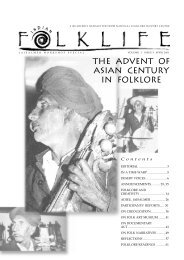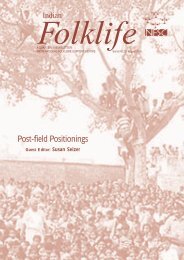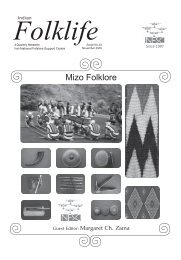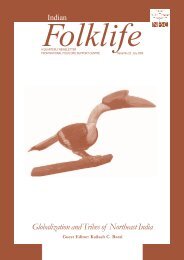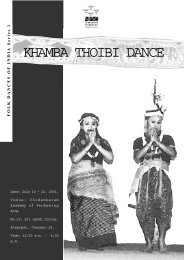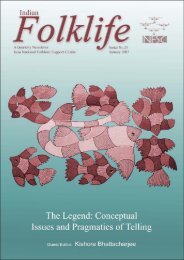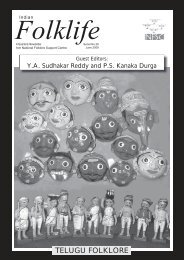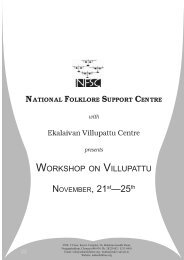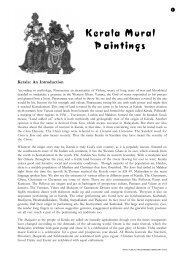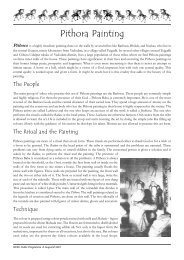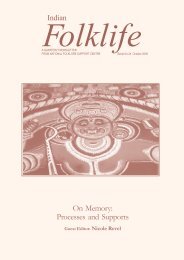Bamboo Flowering in the North-East - Wiki - National Folklore ...
Bamboo Flowering in the North-East - Wiki - National Folklore ...
Bamboo Flowering in the North-East - Wiki - National Folklore ...
You also want an ePaper? Increase the reach of your titles
YUMPU automatically turns print PDFs into web optimized ePapers that Google loves.
This is called jan baha “to make a flower out of bone”imply<strong>in</strong>g <strong>the</strong> regeneration of <strong>the</strong> patril<strong>in</strong>e.Two o<strong>the</strong>r figures, from clanic myths, stress <strong>the</strong> identityof humans and trees: thus bid dare, “to lift a branch ofsal ” alludes to <strong>the</strong> gesture of <strong>the</strong> chiefs dur<strong>in</strong>g <strong>the</strong>migrations, who used to brandish a branch of sal, symbolof <strong>the</strong> ancestors, towards <strong>the</strong> sky to rally <strong>the</strong>ircompanions. Even today, such a branch is planted atcrossroads to <strong>in</strong>form villagers about a meet<strong>in</strong>g, <strong>the</strong> numberof leaves <strong>in</strong>dicat<strong>in</strong>g <strong>the</strong> number of days before <strong>the</strong> event.Planted with its leaves downwards, <strong>the</strong> same branch<strong>in</strong>dicates that a meet<strong>in</strong>g will sanction a transgression ofendogamy. The branch as metonymic for <strong>the</strong> personappears <strong>in</strong> different contexts: <strong>the</strong> expression karam dar“branch of <strong>the</strong> karam tree” is used to address a ceremonialfriend. More globally, branches and sapl<strong>in</strong>gs (dar) alludeto grand-children, roots (rehe) to ancestors, and climbers(nanri) to friends, <strong>in</strong> ceremonial speech dur<strong>in</strong>g marriageor <strong>in</strong> narratives about <strong>the</strong> ancestors. The same metonymyapplies to parts of <strong>the</strong> tree, l<strong>in</strong>ked to parts of <strong>the</strong> body:branch relates to arm, roots to feet, leaves to ears, bark tosk<strong>in</strong>, sap to blood, trunk to body, upper branches to headand so on.The image of <strong>the</strong> ear is also rooted <strong>in</strong> narratives, asancestors used to rest under trees to listen (anjom) to <strong>the</strong>tradition “with <strong>the</strong>ir ears under <strong>the</strong> leaves.” Here, leavesallude to ancestors and cont<strong>in</strong>uity. Reciprocally, to touchsomebody’s ear marks an engagement: young couplescatch each o<strong>the</strong>r’s ears to get betro<strong>the</strong>d. Dur<strong>in</strong>g <strong>the</strong>marriage ceremony, <strong>the</strong> bride’s parents warn <strong>the</strong> parentsof <strong>the</strong> boy that <strong>the</strong>y have given <strong>the</strong> flesh and <strong>the</strong> bones of<strong>the</strong> girl but “have kept <strong>the</strong> blood from <strong>the</strong> ear”, a way tosay <strong>the</strong>y will keep an eye on <strong>the</strong>ir daughter, even aftermarriage.The animal metaphor as an external metaphorDomestic animals, <strong>in</strong>sects, water snails and crabs - whichare eaten by <strong>the</strong> Santals - are found <strong>in</strong> riddles. But tigersand leopards cannot be evoked <strong>in</strong> twisted speech as <strong>the</strong>yserve as witnesses when somebody takes an oath andsays: “Let tigers and leopards eat me if I lie!” Externalmetaphors that are built on comparisons are found <strong>in</strong>animal riddles. Most often, <strong>the</strong> hidden term of thiscomparison refers to ano<strong>the</strong>r animal or to a human be<strong>in</strong>gas <strong>in</strong> <strong>the</strong> follow<strong>in</strong>g: “A black dog is swimm<strong>in</strong>g <strong>in</strong> <strong>the</strong>river” answer: “A leech”: <strong>the</strong> implicit mean<strong>in</strong>g is thatnobody sees <strong>the</strong> legs of a swimm<strong>in</strong>g dog. But my<strong>in</strong>formants suggest ano<strong>the</strong>r homology between <strong>the</strong> dogand <strong>the</strong> leech: “When we work <strong>in</strong> a rice-field” <strong>the</strong>y say,“leeches rub our legs just like a dog.”Yet ano<strong>the</strong>r riddle built on different premises suggestsano<strong>the</strong>r aspect of <strong>the</strong> leech: “A sheep is killed for <strong>the</strong> onewho has no teeth”; answer: “A leech.” Here, <strong>the</strong> kill<strong>in</strong>gof <strong>the</strong> sheep evokes a blood sacrifice to a mysterious entityCourtesy: www.kamat.orgA Santali girldeprived of teeth while <strong>the</strong> answer stresses <strong>the</strong> bloodsuck<strong>in</strong>gnature of <strong>the</strong> leech, which <strong>in</strong> its turn recalls <strong>the</strong>bonga.Some of <strong>the</strong>se external metaphors express paradoxes thatget resolved <strong>in</strong> similarities: t<strong>in</strong>y animals which seem verystrange have, <strong>in</strong> fact, some hidden human dimensions:“With haste, he has built his house”; answer: luman, <strong>the</strong>silkworm. The silkworm symbolises <strong>the</strong> tam<strong>in</strong>g ofwilderness as <strong>the</strong>y produce silk thread, but <strong>the</strong> Santalstalk of <strong>the</strong> silkworm to evoke <strong>the</strong> puberty of young boys.Becom<strong>in</strong>g adult implies a risk that is compared to <strong>the</strong>mutation of <strong>the</strong> silkworms as <strong>the</strong>y emerge from <strong>the</strong>ircocoons, an image which, <strong>in</strong> ritual speech, describes <strong>the</strong>wander<strong>in</strong>g of <strong>the</strong> ancestors across mythic countries.Some of <strong>the</strong> animal riddles are used as warn<strong>in</strong>g. It iscommon to say to a pregnant woman: “Do not look at<strong>the</strong> tortoise!” (hembrom). The Santals th<strong>in</strong>k it a taboofor pregnant women to look at <strong>the</strong> tortoise (flesh andbelly), s<strong>in</strong>ce it evokes <strong>the</strong> open sk<strong>in</strong> of <strong>the</strong> baby’s head.Both anatomical parts are “sk<strong>in</strong> under bone”, which isevident for <strong>the</strong> tortoise but applies equally to <strong>the</strong> babywhose skull is not yet closed, and reflects <strong>the</strong> beat<strong>in</strong>gof its heart. Both <strong>the</strong> belly of <strong>the</strong> tortoise and <strong>the</strong> skullof <strong>the</strong> baby are supposed to get harder to become bone.Moreover, <strong>the</strong> flesh of <strong>the</strong> tortoise is called “bonga kojel” or bonga’s flesh. Infants should avoid touch<strong>in</strong>gtortoises as <strong>the</strong>ir shadow is not yet fixed, and <strong>the</strong>ymay be attacked by bongas.Twisted speech and <strong>the</strong> hidden <strong>in</strong>tentions of discourseIn daily life as well as <strong>in</strong> ritual discourse, utterancestransfer moral attributes to objects that frame specific k<strong>in</strong>dsof <strong>in</strong>teraction, such as “a fowl promised” or sim agom8 INDIAN FOLKLIFE VOLUME 2 ISSUE 3 JANUARY - MARCH 2003



